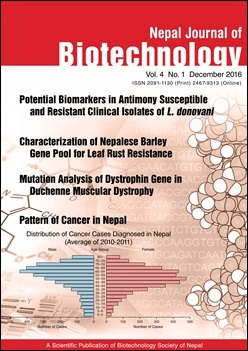Detection of Latent HIV-1 Infection and Drug Resistant Mutation Testing in Nepal: HIV-1 env V3 DNA Sequence and RT Gene (M184V) Mutation
DOI:
https://doi.org/10.3126/njb.v4i1.16342Keywords:
HIV-1, Antiretroviral Therapy, Resistance Mutation, env V3 DNA, RT geneAbstract
HIV-1 resistance to antiretroviral therapy (ART) is a crucial issue, despite various effective drugs are available for the treatment. Although the viral RNA is suppressed below the detection limit (<50 copies/ml) with the use of potent antiviral drugs, the mutation can be archived in the cellular reservoir as proviral DNA. The detection of proviral DNA and mutation screening in HIV 1 RNA for genotypic resistance is the sole basis for monitoring the effectiveness of ART. Our study aim to access the extent of latent HIV infections by detecting env V3 DNA and also testing of M184V (meth184val; ATG - GTG substitution at 184th codon) specific mutations in HIV-1 RT gene to monitor the effectiveness of ART. The HIV-1 env V3 DNA sequence was amplified using multiple upstream and downstream primes to show the latent HIV infections, whereas polymerase chain reaction- restriction fragment digestion assay (PCR-RFDA) was used for testing M184V mutation in HIV-1 RT gene. In the study, out of 15 HIV infected patient blood samples, 12 shows amplification of env V3 DNA, confirming the latent HIV infections while 3 were negative for env V3 DNA. HIV-1 RT gene tested for M184V mutation in all 15 samples showed wild type after analysis using PCR-RFDA. After digestion with CviAII, three bands were observed in wild type whereas in mutant only two bands. Although the study shows negative for the M184V resistance mutation, screening of various panels of drug resistance mutations should be performed in recently infected HIV-1 patients for planning the effective ART strategy. The data is not enough to compare the overall scenario of the Nepal thus warrant urgency for large scale study with standard genotypic tools.
Downloads
Downloads
Published
How to Cite
Issue
Section
License
Copyright Notice:
The manuscript submitted to NJB must be an original contribution, not previously published and should not be under consideration for publication elsewhere. When the manuscript is accepted for publication, the authors agree to automatically transfer the copyright of the article to the publisher. It should grant permission to any third party, in advance and in perpetuity, the right to use, reproduce or disseminate your article, according to the NJB copyright and license agreement.
Authors transfer copyright to the publisher as part of a journal publishing agreement but have the rights to: Share their article for Personal Use, Internal Institutional Use and Scholarly Sharing purposes, with the NJB applies the Creative Commons Attribution-NonCommercial CC BY-NC license to all the works we publish after Jun 2020 (Before it was CC BY-NC-ND). Under this license, authors agree to make articles legally available for reuse, without permission or fees, for virtually any non-commercial purpose. Anyone may remix, adapt, and build upon your work non-commercially, and although their new works must also acknowledge you and be non-commercial, they don’t have to license their derivative works on the same terms. More details on CC BY-NC refer to its Licence Deed and Legal Code.






